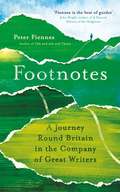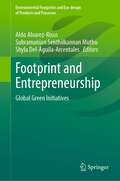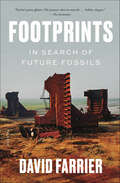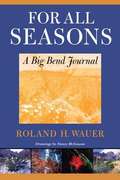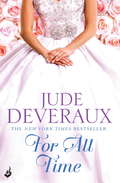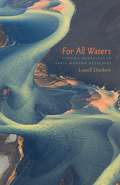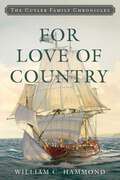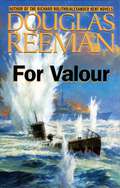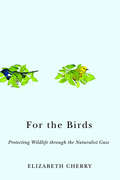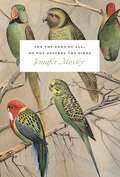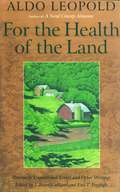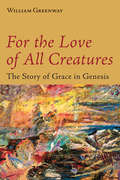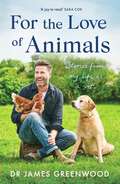- Table View
- List View
Footnotes: A Journey Round Britain in the Company of Great Writers
by Peter Fiennes&‘The premise of this book is simple, or that is what it seemed when I started.&’ Peter Fiennes follows in the footsteps of twelve inspirational writers, bringing modern Britain into focus by peering through the lens of the past. The journey starts in Dorset, shaped by the childhood visions of Enid Blyton, and ends with Charles Dickens on the train that took him to his final resting place in Westminster Abbey. From the wilds of Skye and Snowdon, to a big night out in Birmingham with J. B. Priestley and Beryl Bainbridge, Footnotes is a series of evocative biographies, a lyrical foray into the past, and a quest to understand Britain through the books, journals and diaries of some of our greatest writers. And as Fiennes travels the country, and roams across the centuries, he wonders: &‘Who are we? What do we want? They seemed like good questions to ask, in the company of some of our greatest writers, given these restless times.&’
Footprint and Entrepreneurship: Cases On Circular Economy And Entrepreneurship (Environmental Footprints And Eco-design Of Products And Processes Series)
by Subramanian Senthilkannan Muthu Aldo Alvarez-Risco Shyla Del-Aguila-ArcentalesThis book highlights ten cases of entrepreneurship that – in the context of circular economy – have redefined the paradigm of luxury and the notion of exclusivity that it requires. It shows how, by using technology and a new consumption model, the ten companies have created novel business models for luxury, and more intelligent forms of use better-suited to modern times.
Footprints in Paradise: Ecotourism, Local Knowledge, and Nature Therapies in Okinawa (New Directions in Anthropology #40)
by Andrea E. MurrayThe economic imperative of sustainable tourism development frequently shapes life on small subtropical islands. In Okinawa, ecotourism promises to provide employment for a dwindling population of rural youth while preserving the natural environment and bolstering regional pride. Footprints in Paradise explores the transformation in community and sense of place as Okinawans come to view themselves through the lens of the visiting tourist consumer, and as their language, landscapes, and wildlife are reconstituted as treasured and vulnerable resources. The rediscovery and revaluing of local ecological knowledge strengthens Okinawan or Uchinaa cultural heritage, despite the controversial presence of US military bases amidst a hegemonic Japanese state.
Footprints: In Search of Future Fossils
by David FarrierA profound meditation on climate change and the Anthropocene and an urgent search for the fossils—industrial, chemical, geological—that humans are leaving behindWhat will the world look like in ten thousand years—or ten million? What kinds of stories will be told about us?In Footprints: In Search of Future Fossils, the award-winning author David Farrier explores the traces we will leave for the very distant future. Modern civilization has created objects and landscapes with the potential to endure through deep time, whether it is plastic polluting the oceans and nuclear waste sealed within the earth or the 30 million miles of roads spanning the planet. Our carbon could linger in the atmosphere for 100,000 years, and the remains of our cities will still exist millions of years from now as a layer in the rock. These future fossils have the potential to reveal much about how we lived in the twenty-first century.Crossing the boundaries of literature, art, and science, Footprints invites us to think about how we will be remembered in the myths and stories of our distant descendants. Traveling from the Baltic Sea to the Great Barrier Reef, and from an ice-core laboratory in Tasmania to Shanghai, one of the world’s biggest cities, Farrier describes a world that is changing rapidly, with consequences beyond the scope of human understanding. As much a message of hope as a warning, Footprints will not only alter how you think about the future; it will change how you see the world today.
For All Seasons
by Roland H. WauerSomething about Big Bend National Park draws visitors to it again and again. Maybe it's the spare beauty of the mountains and desert, the dawn chorus of birds, or the vivid stars in the velvet night. All of these things have made it Roland Wauer's favorite place. In this book, he shares his love of the Big Bend through journal entries that chronicle a year in the life of the park. Wauer worked as Chief Park Naturalist from 1966 to 1972 and has visited the park frequently ever since. His journal entries span these thirty years, providing not only a composite portrait of a typical year but also a clear sense of how the park's natural history has changed over three decades. He spices his account with anecdotes, often humorous, ranging from stumbling across a herd of javelinas to being trailed by a mountain lion in the dark to discovering new species of plants and animals. Few authors know the Big Bend as Ro Wauer does or have written about it in a more engaging way. This beautifully illustrated book is the perfect companion for a visit to the park, whether in person or by armchair.
For All Time: Nantucket Brides Book 2 (Nantucket Brides)
by Jude DeverauxFor All Time continues New York Times bestselling author Jude Deveraux's breathtaking Nantucket Brides trilogy, introducing characters from a new generation of Montgomery-Taggerts, the beloved family from her classic novels.At the wedding of Alix Madsen and Jared Montgomery, Jared's cousin Graydon can't look away from bridesmaid, Toby Wyndam. It's not just her quiet beauty or humour - Toby possesses the truly remarkable ability of being able to distinguish Graydon from his identical twin brother, Rory. According to family legend, such a gift marks her as Graydon's True Love.Graydon is heir to the Lanconian throne and must to marry a noble woman who has been chosen for him. Yet, intrigued by Toby, he asks her to help him hide on Nantucket for a week away from regal responsibilities. Knowing their union to be impossible, they promise to simply be friends.But there are forces at work beyond their control, which are ruled by time itself and a seductive spell is cast over Graydon and Toby. If they are to be together, they must change what once was, as well as what will be.Jude Deveraux. Love stories to enchant you.Read Alix and Jared's unforgettable love story in True Love, the first in the Nantucket Brides trilogy and look for the third gorgeous romance in Ever After.
For All Waters: Finding Ourselves in Early Modern Wetscapes
by Lowell DuckertRecent years have witnessed a surge in early modern ecostudies, many devoted to Shakespearean drama. Yet in this burgeoning discipline, travel writing appears moored in historicization, inorganic subjects are far less prevalent than organic ones, and freshwater sites are hardly visited. For All Waters explores these uncharted wetscapes. Lowell Duckert shows that when playwrights and travel writers such as Sir Walter Raleigh physically interacted with rivers, glaciers, monsoons, and swamps, they composed &“hydrographies,&” or bodily and textual assemblages of human and nonhuman things that dissolved notions of human autonomy and its singular narrativity. With a playful, punning touch woven deftly into its theoretical rigor, For All Waters disputes fantasies of ecological solitude that would keep our selves high and dry and that would try to sustain a political ecology excluding water and the poor. The lives of both humans and waterscapes can be improved simultaneously through direct engagement with wetness. For All Waters concludes by investigating waterscapes in peril today—West Virginia&’s chemical rivers and Iceland&’s vanishing glaciers—and outlining what we can learn from early moderns&’ eco-ontological lessons. By taking their soggy and storied matters to heart, and arriving at a greater realization of our shared wetness, we can conceive new directions to take within the hydropolitical crises afflicting us today.
For Love of Country (Cutler Family Chronicles)
by William C. HammondCredited with vividly recreating an early chapter in American history with his first novel, A Matter of Honor, William C. Hammond continues the seafaring adventures of the prominent Cutler family of Massachusetts. Set in the years following the American Revolution, this second novel offers an exciting look at the young republic at a time when America remained a weak nation with no navy to protect its prosperous merchant fleet from Barbary pirates or nations intent on crippling its shipping.The novel opens with the capture of the Cutler merchant brig Eagle by Barbary pirates. Young Caleb Cutler and his shipmates are taken as prisoners to Algiers, and his brother Richard, the novel's main protagonist, is sent to North Africa to pay ransoms demanded by the Dey of Algiers. But Richard learns of the Dey's intent to reject the ransom, as well as threats from the British and French, and fights a fierce battle in the Mediterranean with two Arab xebecs. Victorious at sea, Richard travels to Paris to report to John Paul Jones, his former naval commander who now serves as American emissary to the Barbary States, and finds himself involved in a desperate race to save the beautiful Anne-Marie Helvétian and her two daughters from the guillotine.The author's careful historical research and thorough knowledge of sailing and the ways of the sea bring an authenticity to the novel without detracting from the entertaining storyline. Hammond's focus on the American perspective of the Age of Fighting Sail in the years following the American Revolution adds a fresh dimension to historical novels of the period.
For Valour
by Douglas ReemanOdds are long for the British destroyers assigned to escort vital northern convoys through the bitter Arctic Sea in the bloodiest days of WWII. Commander Graham Martineau, still haunted by the loss of his ship and crew to Nazi destroyers, must take on a new command: the Tribal Class destroyer Hakka.
For the Birds: Protecting Wildlife through the Naturalist Gaze (Nature, Society, and Culture)
by Elizabeth CherryOne in five people in the United States is a birdwatcher, yet the popular understanding of birders reduces them to comical stereotypes, obsessives who only have eyes for their favorite rare species. In real life, however, birders are paying equally close attention to the world around them, observing the devastating effects of climate change and mass extinction, while discovering small pockets of biodiversity in unexpected places. For the Birds offers readers a glimpse behind the binoculars and reveals birders to be important allies in the larger environmental conservation movement. With a wealth of data from in-depth interviews and over three years of observing birders in the field, environmental sociologist Elizabeth Cherry argues that birders learn to watch wildlife in ways that make an invaluable contribution to contemporary conservation efforts. She investigates how birders develop a “naturalist gaze” that enables them to understand the shared ecosystem that intertwines humans and wild animals, an appreciation that motivates them to participate in citizen science projects and wildlife conservation.
For the Good of All, Do Not Destroy the Birds: Essays
by Jennifer MoxleyIn this collection of essays, the author draws upon a wide range of sources, from Greek mythology and modern poetry to her personal experiences with pigeons and parakeets. Birds and their symbolism in art and literature are featured in each essay.
For the Health of the Land: Previously Unpublished Essays And Other Writings
by Aldo Leopold Scott Russell Sanders J. Baird Callicott Eric T. FreyfogleAldo Leopold's classic work A Sand County Almanac is widely regarded as one of the most influential conservation books of all time. In it, Leopold sets forth an eloquent plea for the development of a "land ethic" -- a belief that humans have a duty to interact with the soils, waters, plants, and animals that collectively comprise "the land" in ways that ensure their well-being and survival.For the Health of the Land, a new collection of rare and previously unpublished essays by Leopold, builds on that vision of ethical land use and develops the concept of "land health" and the practical measures landowners can take to sustain it. The writings are vintage Leopold -- clear, sensible, and provocative, sometimes humorous, often lyrical, and always inspiring. Joining them together are a wisdom and a passion that transcend the time and place of the author's life.The book offers a series of forty short pieces, arranged in seasonal "almanac" form, along with longer essays, arranged chronologically, which show the development of Leopold's approach to managing private lands for conservation ends. The final essay is a never before published work, left in pencil draft at his death, which proposes the concept of land health as an organizing principle for conservation. Also featured is an introduction by noted Leopold scholars J. Baird Callicott and Eric T. Freyfogle that provides a brief biography of Leopold and places the essays in the context of his life and work, and an afterword by conservation biologist Stanley A. Temple that comments on Leopold's ideas from the perspective of modern wildlife management.The book's conservation message and practical ideas are as relevant today as they were when first written over fifty years ago. For the Health of the Land represents a stunning new addition to the literary legacy of Aldo Leopold.
For the Love of All Creatures: The Story of Grace in Genesis
by William GreenwayFresh biblical take on a transcending, divine grace that embraces all of God's creatures This broad-ranging, groundbreaking book by William Greenway unfolds a biblical spirituality centering on love for all creation and all creatures. Greenway rereads the creation and flood narratives in Genesis from an overtly creature-loving perspective that not only inspires care for creation but also reveals sophisticated understandings of faith, grace, and evil vital for twenty-first-century spirituality. Comparing the ancient Israelite cosmology of Genesis both with the ancient Babylonian cosmology of the Enuma Elish and with the modern Darwinian cosmology of Thomas Hobbes's Leviathan, Greenway shows how the Bible in Genesis extends far beyond those other cosmologies in its discernment of the transcending, gracious love of God. Standing at the intersection of animal rights, "green" biblical studies, and philosophical theology, Greenway's For the Love of All Creatures will interest and inform a wide range of readers.
For the Love of All Creatures: The Story of Grace in Genesis
by William GreenwayFresh biblical take on a transcending, divine grace that embraces all of God's creatures This broad-ranging, groundbreaking book by William Greenway unfolds a biblical spirituality centering on love for all creation and all creatures. Greenway rereads the creation and flood narratives in Genesis from an overtly creature-loving perspective that not only inspires care for creation but also reveals sophisticated understandings of faith, grace, and evil vital for twenty-first-century spirituality. Comparing the ancient Israelite cosmology of Genesis both with the ancient Babylonian cosmology of the Enuma Elish and with the modern Darwinian cosmology of Thomas Hobbes's Leviathan, Greenway shows how the Bible in Genesis extends far beyond those other cosmologies in its discernment of the transcending, gracious love of God. Standing at the intersection of animal rights, "green" biblical studies, and philosophical theology, Greenway's For the Love of All Creatures will interest and inform a wide range of readers.
For the Love of Animals: Stories from my life as a vet
by Dr James Greenwood'A joy to read' - SARA COXGrowing up in Yorkshire and with farming blood in his genes, James Greenwood always knew he would end up as a vet.Animals have been part of James' life for as long as he can remember, from pulling lambs on a hilltop farm as a child and having stick insects crawling out of his school uniform in class, to renting a flat behind a zoo in Jersey and finding himself treating a newborn baby elephant as a newly qualified vet. Written with his trademark warmth and humour, James offers a fascinating insight into the world of veterinary medicine with tales of treating cats and dogs, horses, pigs and cows, as well as delving deep into his relationship with his beloved and much-missed, one-eyed Labrador, Oliver.However, the path to realising his childhood ambition has not always been easy and at times he has questioned whether it truly is the best job in the world. Through all of the challenging lows and extraordinary highs, it has been the animals themselves that have spurred James on to want to continue vetting and helping him find his calling as a GP vet. Warm, poignant and full of heart, James' story is both a beautiful tribute to the role animals play in our lives and a rare glimpse into what it's really like to be a vet, and is perfect for fans of Matt Baker, The Yorkshire Shepherdess and The Supervet.
For the Love of Animals: Stories from my life as a vet
by Dr James Greenwood'A joy to read' - SARA COXGrowing up in Yorkshire and with farming blood in his genes, James Greenwood always knew he would end up as a vet.Animals have been part of James' life for as long as he can remember, from pulling lambs on a hilltop farm as a child and having stick insects crawling out of his school uniform in class, to renting a flat behind a zoo in Jersey and finding himself treating a newborn baby elephant as a newly qualified vet. Written with his trademark warmth and humour, James offers a fascinating insight into the world of veterinary medicine with tales of treating cats and dogs, horses, pigs and cows, as well as delving deep into his relationship with his beloved and much-missed, one-eyed Labrador, Oliver.However, the path to realising his childhood ambition has not always been easy and at times he has questioned whether it truly is the best job in the world. Through all of the challenging lows and extraordinary highs, it has been the animals themselves that have spurred James on to want to continue vetting and helping him find his calling as a GP vet. Warm, poignant and full of heart, James' story is both a beautiful tribute to the role animals play in our lives and a rare glimpse into what it's really like to be a vet, and is perfect for fans of Matt Baker, The Yorkshire Shepherdess and The Supervet.
For the Record (Camp Rock #2)
by Lucy RugglesWhen a record executive arrives at Camp Rock, Tess is determined to outshine everyone and land the recording deal of a lifetime. The only problem? The record executive isn't at camp for the singing, he´s there for the food! Now Tess will have to get help from the unlikeliest of people--Mitchie.
Forage (Penguin Poets)
by Rose McLarneyA poet acclaimed for "uncompromising, honest poems that sound like no one else" (The Rumpus) now offers considerations of the natural world and humans' place within it in ecopoetry of both ambitious reach and elegant refinementRose McLarney has won attention as a poet of impressive insight, craft, and a "constantly questioning and enlarging vision" (Andrew Hudgins). In her third collection, Forage, she continues to weave together themes she loves: home, heritage, the South, animals, water, the environment. These intricately sequenced poems take up everything from animals' symbolic roles in art and as indicators of ecological change to how water can represent a large, troubled system or the exceptions of smaller, purer tributaries. At the confluence of these poems is a social commentary that goes beyond lamenting environmental degradation and disaster to record--and augment--the beauty of the world in which we live.
Foraging Arizona: Finding, Identifying, and Preparing Edible Wild Foods in Arizona (Foraging Series)
by Christopher NyergesArizona is a diverse area from the Colorado Plateau to the lowland basin and range areas of the Sonoran desert. Foraging Arizona addresses all the traditional plants from mesquite, amaranth, and cactus fruits, to the common urban weeds such as purslane, mallow, and lambs quarter. You'll learn about the edible wild foods and healthful herbs of Arizona. Organized by botanical families with a helpful guide to the environmental zone, this is an authoritative guide for nature lovers and gastronomes. Use Foraging Arizona as a field guide or as a delightful armchair read. No matter what you're looking for, whether it&’s history of how native plants were used or how you can forage some of your meals at home or on hiking trips, this guide will enhance your next backpacking trip or easy stroll around the garden.Inside you'll find:Detailed descriptions of edible plantsTips on finding, preparing, and using foraged foodsA glossary of botanical termsFull-color photos
Foraging California: Finding, Identifying, And Preparing Edible Wild Foods In California (Foraging Series)
by Christopher NyergesFrom acacia to wild grape, Foraging California guides the reader to the edible wild foods and healthful herbs of the Golden State. Helpfully organized by plant families, with detailed information on locations, the book is an authoritative guide for nature lovers, outdoorsmen, and gastronomes.
Foraging California: Finding, Identifying, and Preparing Edible Wild Foods in California (Foraging Series)
by Christopher NyergesFrom acacia to wild grape, Foraging California guides the reader to the edible wild foods and healthful herbs of the Golden State. Helpfully organized by plant families, with detailed information on locations, the book is an authoritative guide for nature lovers, outdoorsmen, and gastronomes.
Foraging Central Grasslands: Finding, Identifying, and Preparing Edible Wild Foods in the Central United States (Foraging Series)
by Bo BrownThe central grasslands support significant biodiversity and parts of the ecoregion are known for being in the top ten ecoregions for reptiles, birds, butterflies, and tree species. The grasslands are dependent upon fires for both its survival and renewal as it keeps the grasslands from turning into a forest. That renewal process lends itself toward fostering diverse plant species with over 100 different plants found in less than 5 acres. The range covers parts of Texas, Oklahoma, Kansas, Nebraska, North and South Dakota, Minnesota, Iowa, Illinois, and Missouri. Foraging Central Grasslands, written by local wilderness expert Bo Brown, highlights about a hundred commonly found edibles from ubiquitous herbs to endemic species. With sidebars, recipes, helpful tips, and toxin warnings throughout, Foraging Central Grasslands is the only guidebook the outdoor enthusiast will need to pick it, cook it, and eat it.
Foraging Florida: Finding, Identifying, and Preparing Edible and Medicinal Wild Foods in Florida (Foraging Series)
by Roger L. HammerPaleo-Indians lived more than 14,000 years ago in the land we now call Florida, and later came tribes of indigenous people known as the Ais, Calusa, Mayaimi, Tequesta, Timucua, and others. Still later came the Seminole and Miccosukee. These people were hunter-fisher-gatherers who lived off the bounty of what nature had to offer. Today, foraging wild fruits, nuts, grains, and other edible plant parts has become an active pastime for outdoor enthusiasts throughout the country, but Florida is a forager&’s paradise due to the wealth of both temperate and tropical native plants.In Foraging Florida, local naturalist Roger Hammer highlights edible and medicinal native and naturalized plants found throughout the state, from the far western Panhandle to the island chain of the Florida Keys. The book is organized by plant family so foragers can learn which species are closely related, and it includes a poisonous plant section so novices will know which plants to avoid. Recipes, identification tips, and how to prepare herbal and medicinal teas are offered throughout this forager&’s guidebook.Detailed description and photos of each plant, including its usesInformation on toxic lookalikes and cautionsRecipes to prepare at home and on the trailA glossary of botanical terms
Foraging Idaho: Finding, Identifying, and Preparing Edible Wild Foods (Foraging Series)
by Christopher NyergesThis valuable reference guide will help you identify and appreciate the continually changing list of wild, harvestable treasures of Idaho.Inside you'll find: detailed descriptions of edible plants and animals; tips on finding, preparing, and using foraged foods; a glossary of botanical terms; full-color photos. Use Foraging Idaho as a field guide or as a delightful armchair read. No matter what you're looking for, be it the curative Heal-All or tasty Purslane, this guide will enhance your next backpacking trip or easy stroll around the garden, and may just provide some new favorites for your dinner table.
Foraging Idaho: Finding, Identifying, and Preparing Edible Wild Foods (Foraging Series)
by Christopher NyergesFrom ferns to trees, roots to fruits, native plants to the many introduced exotics, this guide uncovers the edible wild foods and healthful herbs of Idaho. Helpfully organized by families, with a guide for each environmental zone, the book is an authoritative guide for nature lovers, outdoorsfolks, and gastonomes.
